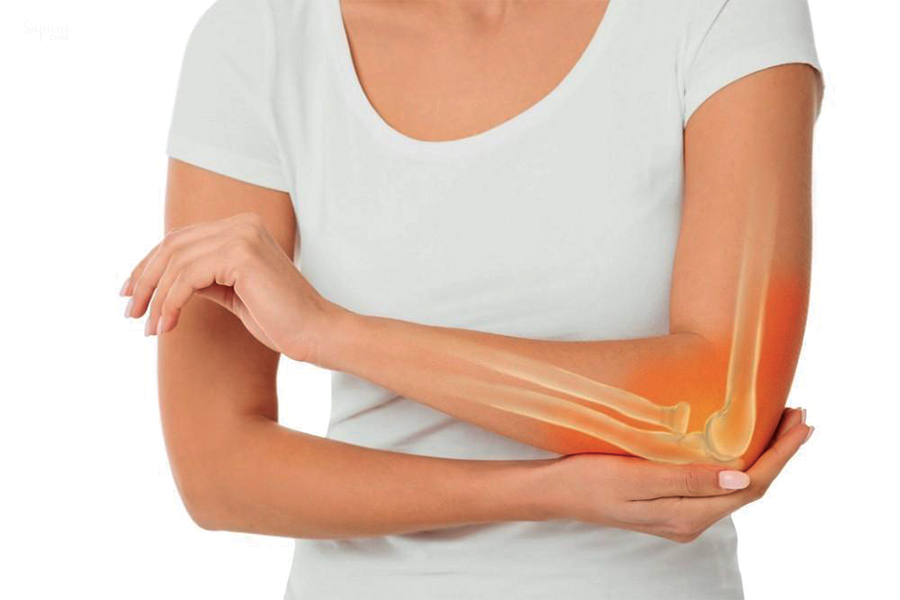Elbow Arthritis: Diagnosis and Treatment in Malleshwaram
Elbow arthritis is a condition characterized by inflammation and degeneration of the elbow joint, leading to pain, stiffness and reduced mobility. At Sapiens Clinic in Malleshwaram, we specialize in the comprehensive evaluation and management of elbow arthritis, aiming to restore function and improve quality of life for our patients.
Understanding Elbow Arthritis
Arthritis of the elbow can result from various underlying conditions, including :
- Osteoarthritis: A degenerative joint disease caused by wear and tear of the cartilage, leading to bone-on-bone contact and joint damage.
- Rheumatoid Arthritis: An autoimmune disorder where the immune system attacks the joint lining, causing inflammation and joint destruction.
- Post-Traumatic Arthritis: Develops after an injury to the elbow, such as a fracture or dislocation, leading to joint instability and degeneration over time.
These conditions can lead to chronic pain, decreased range of motion, and functional limitations.
Causes and Risk Factors
Several factors can contribute to the development of elbow arthritis :
- Age: The risk increases with age due to cumulative joint wear.
- Repetitive Movements: Occupations or activities involving repetitive elbow motions can accelerate joint degeneration.
- Previous Injuries: Past fractures or dislocations can predispose the elbow to arthritis.
- Autoimmune Conditions: Diseases like rheumatoid arthritis increase the risk.
- Genetic Predisposition: Family history of arthritis can be a contributing factor.
Symptoms
Common symptoms of elbow arthritis include :
- Pain: Especially during movement or after activity.
- Stiffness: Difficulty in bending or straightening the elbow.
- Swelling: Around the joint due to inflammation.
- Grinding Sensation: A feeling of bones rubbing together.
- Reduced Range of Motion: Limiting daily activities.
Diagnosis
Accurate diagnosis is essential for effective treatment :
- Physical Examination: Assessing pain, swelling, and range of motion.
- Imaging Studies: X-rays to detect joint space narrowing, bone spurs, or other changes. MRI or CT scans may be used for detailed evaluation.
- Laboratory Tests: Blood tests to identify markers of inflammation or autoimmune activity.
Treatment Options
Treatment is tailored based on the severity and underlying cause:
Non-Surgical Treatments
- Medications: NSAIDs to reduce pain and inflammation.
- Physical Therapy: Exercises to improve flexibility and strength.
- Activity Modification: Avoiding activities that exacerbate symptoms.
- Bracing: Using elbow supports to stabilize the joint.
- Injections: Corticosteroid injections to reduce inflammation.
Surgical Treatments
If conservative measures fail, surgical options may be considered:
- Arthroscopy: Minimally invasive procedure to remove loose bodies or bone spurs.
- Synovectomy: Removal of inflamed joint lining in rheumatoid arthritis.
- Joint Replacement: In severe cases, replacing the damaged joint with a prosthesis.
Recovery and Rehabilitation
Post-treatment rehabilitation focuses on restoring function:
- Physical Therapy: Customized exercises to regain strength and mobility.
- Pain Management: Medications and modalities to control discomfort.
- Regular Follow-Up: Monitoring progress and adjusting treatment as needed.
Recovery time varies depending on the treatment approach and individual factors.
Conclusion
Elbow arthritis can significantly impact daily activities, but with timely and appropriate management, symptoms can be alleviated, and function restored. At Sapiens Clinic, Malleshwaram, Dr. Darshan Kumar A. Jain and our dedicated team are committed to providing comprehensive care tailored to each patient’s needs. If you’re experiencing elbow pain or stiffness, schedule a consultation to explore your treatment options.
FAQs
1. Can elbow arthritis be cured?
While arthritis cannot be cured, its symptoms can be effectively managed with appropriate treatment.
2. How long does recovery take after elbow surgery?
Recovery varies but typically ranges from several weeks to a few months, depending on the procedure and individual healing.
3. Are there risks associated with elbow surgery?
As with any surgery, risks include infection, nerve damage or prosthesis issues, but these are relatively rare.
4. Can lifestyle changes help manage elbow arthritis?
Yes, maintaining a healthy weight, regular exercise, and avoiding repetitive strain can help manage symptoms.
5. When should I see a doctor for elbow pain?
If you experience persistent pain, swelling or reduced mobility in your elbow, it’s advisable to consult a healthcare professional for evaluation.

Leave a Reply